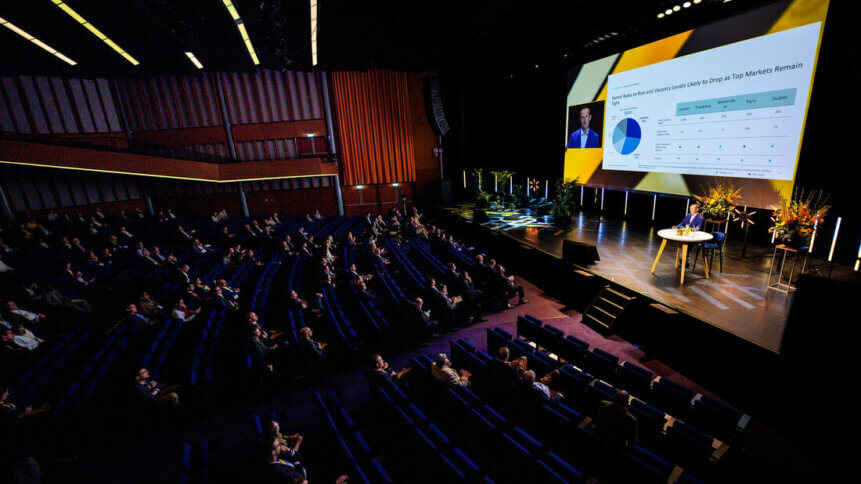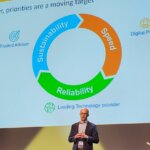Kickstart Europe – the outlook for the European data center market

At Kickstart Europe – Europe’s leading data center conference this year – one of the most obviously hot topics after the ups and downs of 2022 was the outlook for the European data center market across the course of 2023.
Paul Mortlock, Head of EMEA Data Center Capital at CBRE, took to the stage to tackle the big questions and to at least try and calm some fluttering hearts among the audience.
The outlook for the European data center market was fine, he assured the crowd. Yes, absolutely, there were challenges to negotiate – the energy price crisis that’s being most acutely felt in Europe as a result of Russia’s illegal invasion of Ukraine was proving to be a stubborn issue, and the inflation to which it was leading was another. But, he said, the sector was starting the year on a high note, with take-up levels expected to break 400 MW this year.
The combination of honest acknowledgement of the challenges facing the industry and a relentless optimism nevertheless went down well with the audience, almost all of whom were deeply entangled in the data center industry and its successes or failures.
Inflationary factors.
Mortlock went on to name-check some European cities particularly – London, he said, had the most capacity of any major metropolis across what, post-Brexit, it becomes increasingly inaccurate to describe as “the European market” when including Britain in the equation. Meanwhile, Paris was expected to catch up with its two leading competitors during the course of 2023, while Frankfurt looked likely to be the most supply-constricted city in Europe.
There was a reluctance, he acknowledged, on the part of the hyperscalers like Microsoft and AWS to simply swallow the inflation-spike – which could cause some issues, given that the hyperscalers were responsible for 80% of take-up in 2022, which was a stellar year. While in itself, Morrtlock said he expected 2023 to be a very similar year, the likelihood was that take-up would increase very slightly, swimming against those macroeconomic challenges that had wrought such hardship across the European economy as a whole.
But if there were sticking points with the hyperscalers and inflation, Mortlock brought bounty too – he explained that new players were joining the market. ByteDance, parent of the increasingly ban-prone but relentlessly popular TikTok short video platform, had joined the European market, and so long as it continued to need relatively local data centers in Europe, it might well be relied upon to grow the sector.
There was also an encouraging trend to watch from the US, he said – the increasing scale of individual deals. That meant that every individual headline deal, acquisition, or new center would likely be worth more, and as such be a source of greater optimism as the sector rowed its way upstream against the current of power prices and the rising tide of inflation.
A changing market.
In addition to new players and a higher value-per-deal ratio, Mortlock noted that there were more build-to-suits on the horizon, meaning a leaner, more precision-engineered landscape, and as such, a more reliable outlook for the European data center market as a whole. Top operators like Equinix, Digital Realty, and Virtus, he said, were key to this slight but significant re-shaping of the market.
“There’s a shortage of land and contractors where the hyperscalers want to go,” he explained, which meant that new cities in the picture were beginning to show significant growth, as they became the best available option that would meet the significant needs of those hyperscalers.
“And where hyperscalers go, geolocators follow – and the good news is that they’re going more or less everywhere,” he reassured the crowd.
The outlook for the European data center market across 2023, he said, would to some extent be actively driven by these geographical factors, he explained. “NTT is in Frankfurt, Virtus is in London, and so on.”
That, matched with the prediction that inflation is set to fall – and in the relatively short term – gave the crowd at Kickstart Europe plenty of red meat about which they, their CEOs, and ultimately their shareholders could be both reassured and relatively optimistic. “We at CBRE see the demand curve steepening, rather than flattening in the short term,” he said.
“The colocation market will continue to grow at a considerable clip. The FLAPD market (Frankfurt, London Amsterdam, Paris, Dublin) will see Frankfurt and London representing over half the projected take-up in 2023, with Paris closing the gap. But there are also a number of good reasons why we’re seeing significant growth outside the FLAPD market, in fast-growing Tier 2 markets like Berlin, Milan, Warsaw, Madrid, Oslo and Zurich, as the hyperscalers spread their need for data centers around and feed this Tier 2 market. And the Nordic countries are also coming hugely into favor as the cheap green energy available there becomes more and more significant in where hyperscales and colocators both site their centers.
A new set of markets.
“The net result of all these drivers are a set of markets – let’s say 30 of them that are not FLAPD – that make up over half of the 5GW of colocation capacity we see across Europe.”
The overall message of Mortlock’s predictions on the outlook for the European data center market across 2023 was one of positivity in spite of geopolitics and macroeconomics.
But it’s fair to say that what may be the concise takeaway from his presentation is that 2023 will see a continuing need for data centers by the hyperscalers, matched with increasing restrictions on size, labor availability and power costs in the traditional FLAPD market.
That in turn looks like it will lead to a geographical spreading of the wealth across the Tier 2 market, with new countries feeling the economic uplift of new data centers – with the Nordic countries in particular set to capitalize on their green energy strategies in a market that may be increasingly squeezed over power costs as the year goes on.










